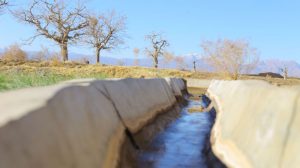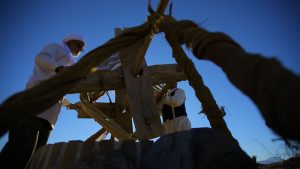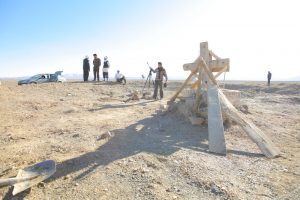
Qanats transport water from elevated sources through underground tunnels to an outlet for irrigation. Photo courtesy of Komeil Soheili.
If you and your pals were planning to start a new civilization, you would probably think twice about settling in the middle of a desert that receives less than 127 mm (5 in.) of rainfall per year.
But such practical concerns didn’t faze the Persians entering the desert in present-day Iran more than 3000 years ago. Knowing they could not look to the sky for the water their fledgling civilization would need to survive, these artisans turned to qanats. These hand-built irrigation systems were comprised of long, sloping, underground tunnels that transported water from elevated sources down to the arid plains where they wished to settle, according to the United Nations Educational, Scientific, and Cultural Organization (UNESCO) “The Persian Qanat” website. UNESCO named the Persian qanats a World Heritage Site in 2016.
These gravity-flow tunnels are remarkable feats of engineering and construction. Most are about 1.5 m-by-0.75 m (5-ft by 2.5-ft) in size, with some located as much as 61 m (200 ft) below the dry surface, according to Livius.org’s “Qanat” webpage. And the deserts in modern Iran hold thousands of them, spanning about 350,000 km (217,000 mi) in length in total, or almost the distance between the Earth and the moon, according to the May 31, 2017 article in National Geographic, “See the Ancient Water Tunnels Below Iran’s Desert.”
A qanat’s path can be traced from above by the air shafts that were bored every few feet to release dust and provide oxygen to the diggers. Worker rest areas, water reservoirs, and watermills were included in their complex design, the UNESCO website says.

Well shafts at regular intervals along the qanat tunnel allow caretakers to remove soil and allow ventilation. Photo courtesy of Soheili.
Those who dug qanats, known as muqannis, were talented surveyors. Each tunnel had to slope enough to allow water to flow freely through it, but not so steep that the streaming water might erode and eventually collapse the tunnel. This level of precision often was difficult to achieve, given that a single qanat could be (64-km) 40-mi long. Once completed, each had to be faithfully cleaned in the spring, a painstaking, annual process necessary to maintain proper flow, according to Livius.org.
When built, there were neither local water authorities to manage the qanats’ operation and maintenance, nor regulatory bodies to litigate any disputes between villages that tapped into the water supply. Qanats were communal water management systems; equitable water sharing, distribution, and maintenance all were part of an unspoken contract among users, according to the Middle East Institute (Washington, D.C.) article, “Harvesting Water and Harnessing Cooperation: Qanat Systems in the Middle East and Asia”.

Soheili produced a video for National Geographic about qanats and passing down the heritage of maintaining them in his native Khorasan Province. Photo courtesy of Soheili.
Both qanat design and the system for managing them proved effective, allowing one of the world’s oldest civilizations to expand and flourish. Remnants of these systems continue to operate throughout Iran. That is due in large part to mirab – caretakers of the qanats – who passed down the skills of their trade from one generation to the next, according to the National Geographic article.
But the long-term future of these ancient water management systems is at risk. The communal approach to maintenance has grown increasingly impractical during the past 50 years, with a new focus on decision-making by individual farmers. The large estates that house the tunnels have been subdivided, making it no longer clear who is responsible for tunnel maintenance, National Geographic says.

Gholamreza Nabipour, age 102, is one of the last remaining caretakers of qanats known as mirabs. Photo courtesy of Soheili.
Qanats have become less a way of life and more of a hobby, according to Komeil Soheili, an Iranian filmmaker who produced a video about the qanats in his native Khorasan Province. “It’s not possible to feed your family and earn money by working in qanats,” he explained to National Geographic.
Gholamreza Nabipour, one of the last remaining mirabs at the age of 102, has passed on all he knows about their maintenance to one of his sons, who continues to use a qanat to irrigate his pistachio farm. “These qanats have been the source of life for me and all of my ancestors,” said Nabipour in Soheili’s video. “It’s my duty to preserve them until the last second of my life.”
— Mary Bufe, WEF Highlights
Follow Water History Articles in WEF Highlights
|








April 30, 2018
Featured